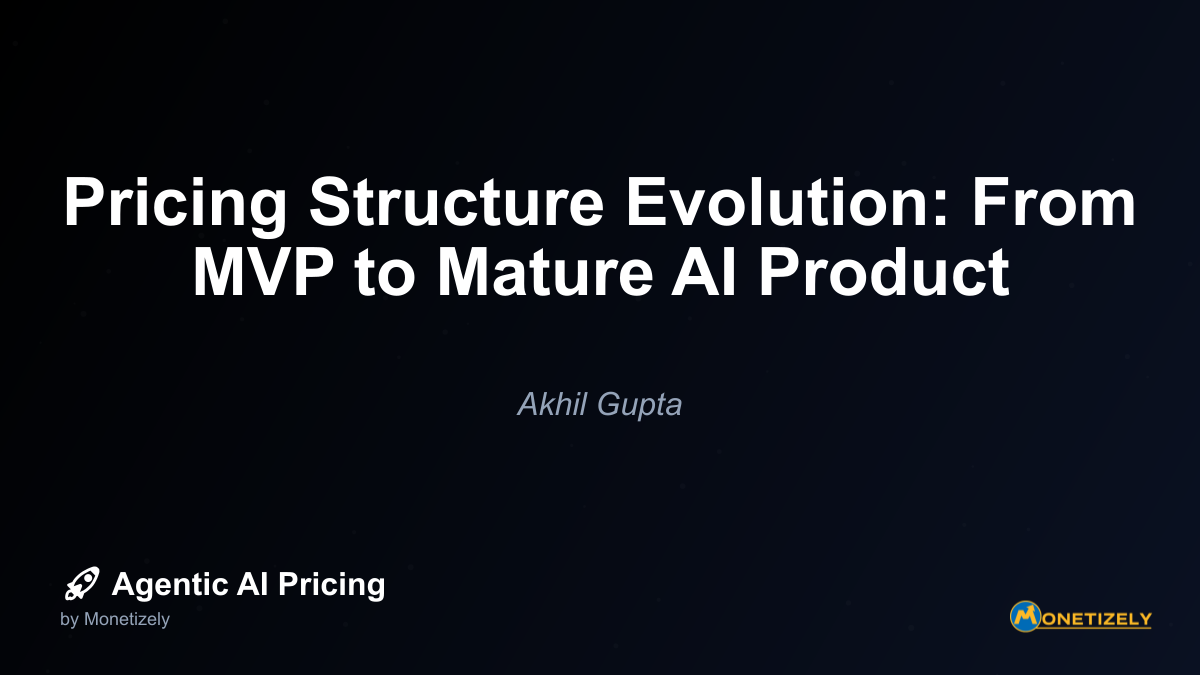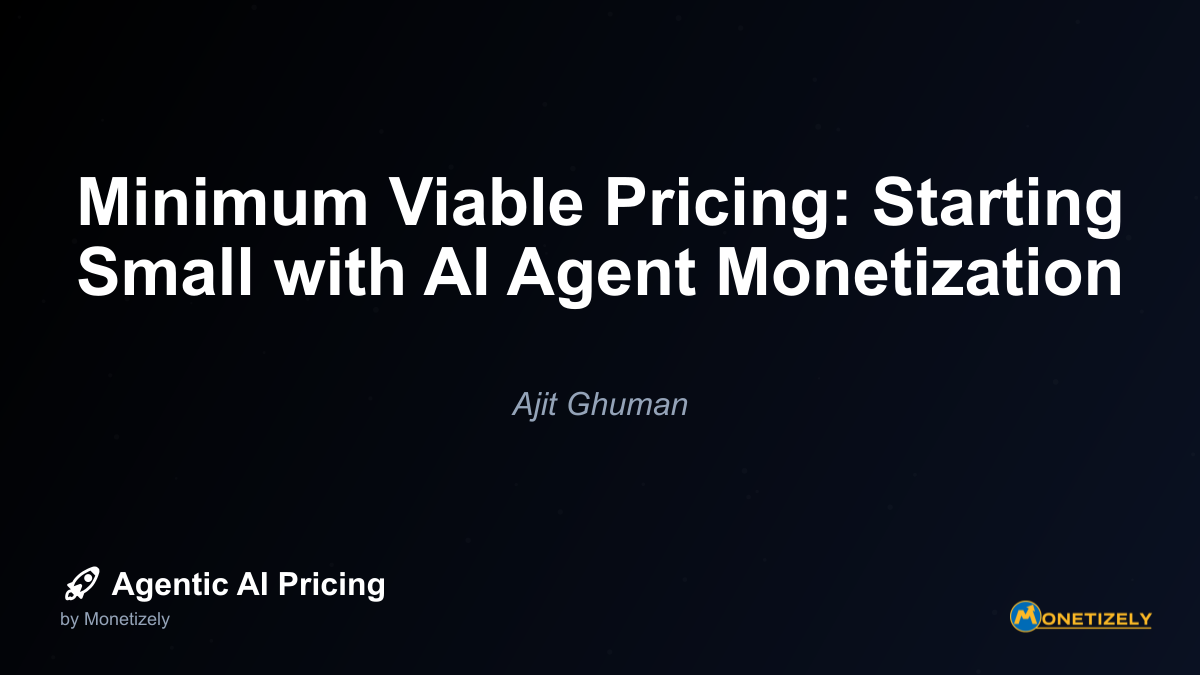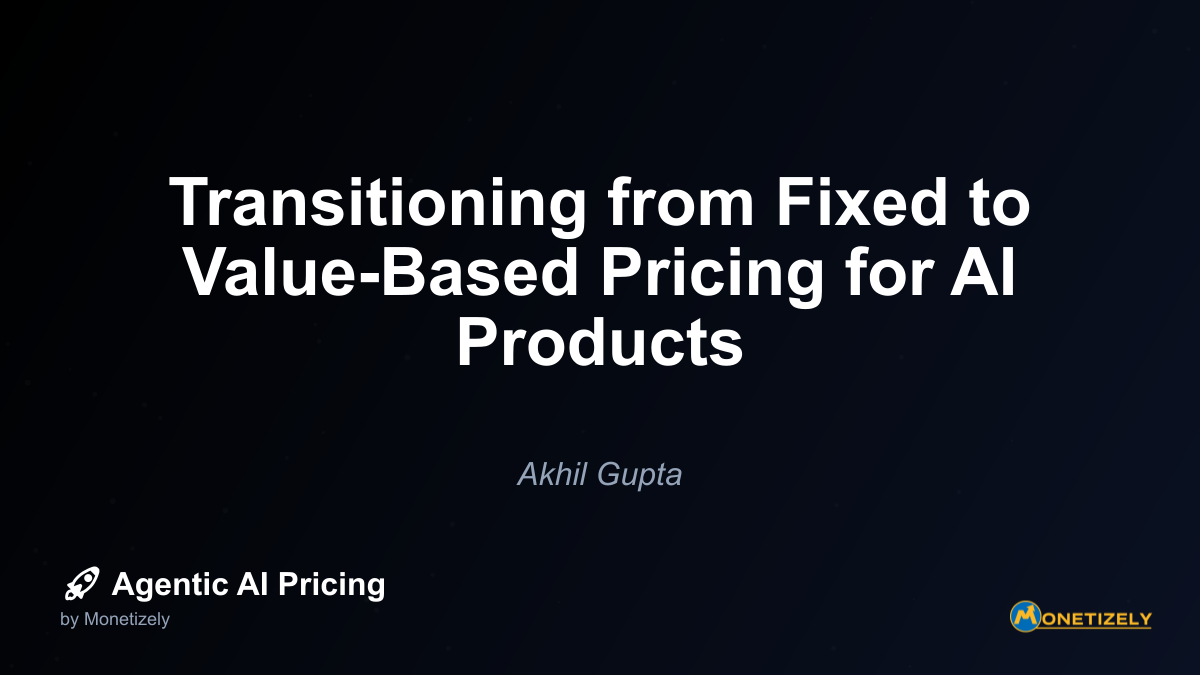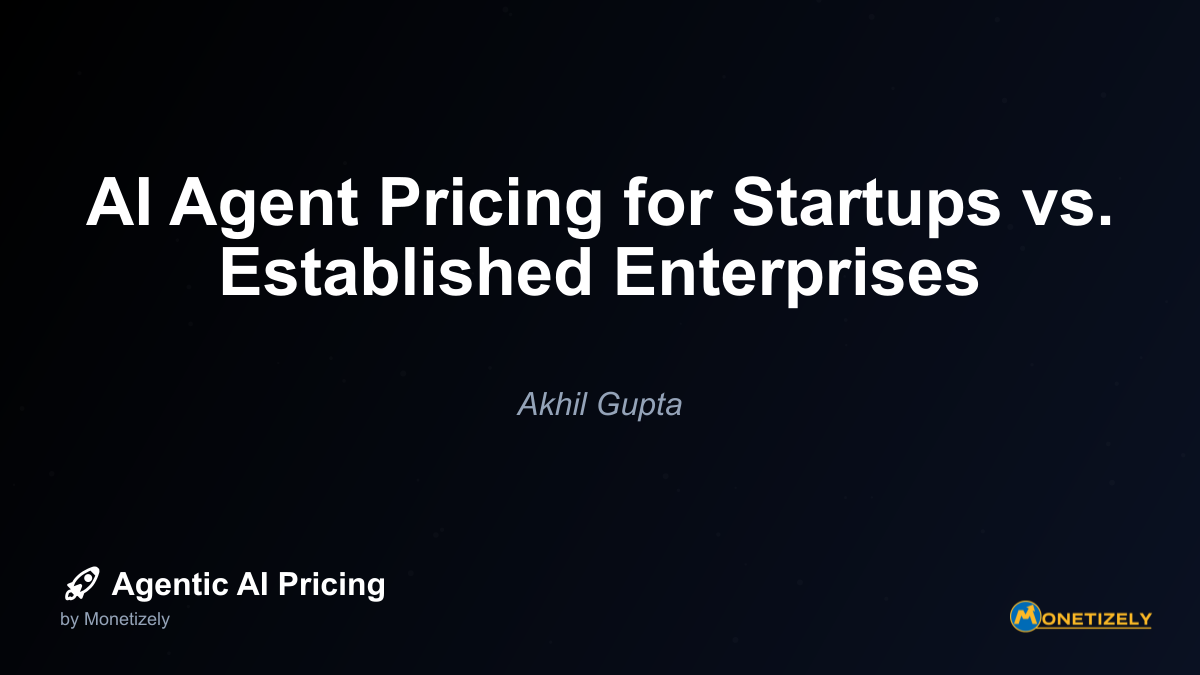· Akhil Gupta · Strategy · 13 min read
Pricing Structure Evolution: From MVP to Mature AI Product
AI and SaaS Pricing Masterclass
Learn the art of strategic pricing directly from industry experts. Our comprehensive course provides frameworks and methodologies for optimizing your pricing strategy in the evolving AI landscape. Earn a professional certification that can be imported directly to your LinkedIn profile.

The evolution of pricing structures for AI products represents one of the most critical strategic challenges facing companies today. As AI solutions progress from early MVP stages to mature market offerings, pricing models must adapt to reflect changing value propositions, cost structures, and customer expectations.
The Fundamental Shift in AI Pricing Paradigms
Traditional software pricing models—primarily seat-based subscriptions—are increasingly proving inadequate for AI products. Recent market data shows a dramatic shift: seat-based pricing dropped from 21% to 15% of AI firms within a 12-month period, while hybrid and outcome-based pricing surged to 41%. This evolution is not merely a trend but a necessity driven by the unique economics of AI solutions.
Companies clinging to outdated seat-based models face approximately 40% lower gross margins and more than twice the churn compared to those adopting more sophisticated pricing approaches. The reason is clear: per-user pricing fails to capture the true value of AI, especially as these technologies dramatically amplify productivity—for instance, Alphabet now generates 30% of its code through AI assistance.
The Three Stages of AI Product Pricing Evolution
Stage 1: MVP and Early Adoption Pricing
In the initial MVP stage, AI products typically employ simplified pricing models designed to reduce friction and accelerate adoption. Key characteristics include:
Simplified Subscription Models: Early-stage AI products often start with straightforward seat-based or flat-fee pricing to minimize complexity and lower adoption barriers.
Experimentation: Data shows AI firms test an average of 3.2 different pricing approaches within their first 18 months of operation, highlighting the experimental nature of this phase.
Focus on Validation: Pricing at this stage aims to validate product-market fit and gather usage data rather than optimize revenue or margins.
Limited Differentiation: Early pricing typically offers minimal tiers or customization as companies focus on core functionality and adoption.
The primary metrics during this phase include Cost Per Query (CPQ) to establish baseline operational costs, Time-to-Value (TTV) to demonstrate efficiency gains, and early Customer Lifetime Value (CLV) estimates to validate initial pricing hypotheses.
A critical challenge at this stage is balancing simplicity with sustainability. While simplified pricing models accelerate adoption, they must still cover the substantial infrastructure costs that represent the #1 growth constraint for 67% of AI startups.
Stage 2: Growth and Scaling Pricing
As AI products gain traction and usage patterns diversify, pricing models must evolve to reflect the heterogeneous value delivered to different customer segments. Key characteristics include:
Transition to Value-Based Models: Companies begin implementing hybrid models that combine usage and outcome elements, better aligning price with delivered value.
Differentiated Tiers: More sophisticated feature bundling emerges, with pricing tiers reflecting different levels of capability, customization, and support.
Usage-Based Components: Token-based, API call-based, or output-based pricing elements become more common to tie costs directly to consumption and value.
Segmentation: Pricing strategies become more nuanced, with different approaches for enterprise vs. SMB customers, or for different vertical markets.
During this phase, companies should focus on metrics such as Token Utilization Ratio to refine tiered pricing structures, Resolution Rate and Error Rate to improve product reliability, and Price Sensitivity Index to gauge elasticity across different customer segments.
Copy.ai exemplifies this evolution, having shifted from simpler subscription models to output-based pricing that charges customers $0.02 per AI-generated paragraph. This approach directly links cost to customer value and consumption, helping the company maintain impressive 95% gross margins by aligning pricing closely with infrastructure costs.
Stage 3: Mature Product Pricing
As AI products reach maturity, pricing models become highly sophisticated, emphasizing value optimization, customer retention, and competitive differentiation. Key characteristics include:
Outcome-Based Pricing: Mature AI products increasingly tie pricing to measurable business outcomes rather than just usage or features.
Dynamic and Flexible Models: Pricing adapts to changing usage patterns, with innovations like off-peak pricing (offering discounts during lower-demand periods) to optimize infrastructure utilization.
Ecosystem Integration: Pricing reflects the AI product’s position within broader solution ecosystems, with bundling and integration pricing becoming more important.
Enterprise Value Alignment: Sophisticated ROI models demonstrate clear business impact, supporting premium pricing for high-value applications.
In this stage, companies should track metrics such as Resource Utilization Peaks for dynamic/tiered pricing optimization, Quality Scores to justify premium pricing, and mature CLV, Churn Rate, and Feature Utilization Analysis for retention and upsell strategies.
DeepSeek, a Chinese AI startup, illustrates mature pricing innovation with its off-peak pricing strategy—offering discounts up to 75% during lower demand periods. This approach optimizes infrastructure utilization while providing cost benefits to price-sensitive customers.
The Infrastructure Cost Challenge
A unique challenge in AI pricing evolution is addressing the substantial and often unpredictable infrastructure costs that underpin these solutions. Unlike traditional software with its high gross margins (typically 80-90%), AI products often operate at 50-60% margins due to compute requirements.
Recent data reveals that 67% of AI startups cite infrastructure costs as their primary growth constraint. Additionally, only 23% of enterprises can accurately forecast their AI spend month-to-month, highlighting the significant uncertainty in resource consumption and cost prediction.
This cost pressure creates a fundamental tension in AI pricing: models must generate sufficient revenue to cover infrastructure expenses while remaining attractive and predictable for customers. Companies are responding with several strategies:
Transparent Usage Dashboards: Providing customers with clear visibility into their consumption patterns and associated costs.
Tiered Credit Systems: Implementing token or credit systems (like HubSpot’s AI Assistant) where customers prepay for AI usage, allowing for budget predictability.
Infrastructure Optimization: Developing more efficient models and implementing techniques like caching to reduce compute costs without compromising performance.
Dynamic Resource Allocation: Implementing systems that dynamically allocate computing resources based on demand, optimizing cost efficiency.
As one industry expert noted, “The economics of AI are fundamentally different from traditional SaaS. Ignoring the infrastructure cost reality leads to unsustainable pricing models that erode margins or drive customer churn.”
Customer Experience and Pricing Communication
Successfully evolving pricing models requires careful attention to customer experience and communication. The transition between pricing models can create significant friction if not managed properly, potentially leading to customer confusion, dissatisfaction, or churn.
Best practices for managing pricing evolution include:
Purposeful Transition Planning
Avoid abrupt changes that can alienate existing customers. Instead, develop a carefully phased approach:
Test with Strategic Customers: Pilot new pricing structures with select customers to gather feedback before broader rollout.
Clear Communication: Provide transparent explanations of the rationale behind pricing changes, emphasizing the value alignment benefits.
Adequate Transition Time: Build sufficient notice periods and transition windows into implementation plans.
Grandfathering Options: Consider offering existing customers the option to remain on legacy pricing for a defined period.
Building Measurement and Billing Capabilities
Evolving pricing models require sophisticated systems to track usage, measure outcomes, and manage billing:
Robust Telemetry: Invest in comprehensive usage tracking across all AI features and capabilities.
Value Baselining: Establish clear benchmarks to measure the value delivered by AI features.
Flexible Billing Infrastructure: Develop systems capable of supporting multiple pricing models simultaneously during transitions.
Usage Forecasting: Implement tools to help customers predict their consumption and associated costs.
Case Studies in AI Pricing Evolution
Copy.ai: From Subscription to Output-Based Pricing
Copy.ai’s journey illustrates a successful pricing evolution aligned with product maturity:
Early Stage: Started with simpler subscription or user-based models common in early SaaS AI products.
Mature Stage: Transitioned to output-based pricing, charging customers $0.02 per AI-generated marketing copy paragraph.
Benefits: This model directly links cost to customer value and AI output, improving gross margins to approximately 95% by aligning pricing closely with cloud costs.
Challenges: Required developing precise cost tracking and forecasting infrastructure to maintain margins and avoid customer overcharging or underbilling.
This evolution demonstrates how pricing can mature from simple subscriptions to sophisticated value-based models that better reflect both the cost structure and value delivery of AI solutions.
HubSpot: Token-Based AI Pricing
HubSpot’s approach to pricing its AI Assistant showcases another evolutionary path:
Pricing Model: Implemented a token-based pricing system where customers prepay for AI credits (tokens), with each token representing a specific AI action (e.g., one token per AI-generated email).
Customer Benefits: Provides predictability for budgeting while allowing flexibility in usage allocation.
Business Benefits: Shifts some infrastructure cost risk to customers while providing predictable revenue streams.
Implementation Requirements: Demanded transparent usage dashboards for customers to track consumption and forecast needs.
This token-based approach represents a sophisticated middle ground between simple subscriptions and pure usage-based pricing, offering both predictability and alignment with actual consumption.
DeepSeek: Off-Peak Pricing Innovation
DeepSeek’s pricing innovation demonstrates how mature AI products can implement sophisticated models that optimize both customer value and infrastructure efficiency:
Pricing Strategy: Introduced off-peak pricing with discounts up to 75% during lower demand periods.
Target Market: Primarily aimed at developers integrating AI models globally, who have flexibility in when they run workloads.
Benefits: Reduced costs for price-sensitive customers while improving infrastructure utilization and spreading demand more evenly.
Implementation Challenges: Required sophisticated demand forecasting and dynamic pricing mechanisms.
This approach shows how mature AI pricing can go beyond simple feature/tier differentiation to incorporate time-based and demand-based elements that benefit both customers and providers.
Strategic Frameworks for Testing and Validating Pricing Evolution
Successfully evolving pricing models requires systematic testing and validation frameworks. For AI products, traditional pricing test methodologies must be adapted to account for the unique characteristics of these solutions.
Value-Based Segmentation Testing
Rather than applying one-size-fits-all pricing, companies should:
Identify distinct user segments based on industry, company size, usage patterns, and the specific value derived from AI features.
Conduct willingness-to-pay studies through surveys, interviews, and preference testing with each segment.
Develop segment-specific pricing strategies that reflect different value perceptions and usage intensities.
This approach helps uncover high-value segments willing to pay more versus growth segments requiring affordable entry points.
Multi-Dimensional A/B Testing
Instead of testing isolated price points, design experiments that compare:
- Different pricing models (subscription, usage-based, hybrid)
- Feature bundling and tiering structures
- Price sensitivity tied to specific AI capabilities
- Response to promotional offers
This comprehensive approach reveals how pricing structure and feature value intersect to impact adoption and revenue.
Usage Pattern Analysis
Since AI products often exhibit high variability in resource consumption, implement frameworks that:
- Model different usage intensities and peak vs. average demands
- Analyze the correlation between usage patterns and customer value perception
- Design pricing models that balance profitability with fairness and user adoption
This analysis is essential for developing sustainable pricing that accurately reflects both costs and value.
Iterative Pricing Optimization
Apply the TEST Framework:
- Trial pricing experiments sequentially, changing one variable at a time
- Evaluate competing pricing models with controlled user groups
- Scale validated pricing models across new segments or geographies
- Track key metrics including churn, expansion revenue, and customer satisfaction
This systematic approach enables continuous refinement and optimization of pricing strategies throughout the product lifecycle.
Metrics and KPIs for Guiding Pricing Evolution
Effective pricing evolution requires tracking specific metrics at each stage of the AI product lifecycle:
MVP Stage Metrics
- Cost Per Query (CPQ): Tracks baseline cost per interaction to ensure pricing covers operational expenses.
- Time-to-Value (TTV): Measures how quickly customers realize value, validating early pricing against delivered benefits.
- Early Customer Lifetime Value (CLV) Estimates: Provides initial indicators of long-term customer economics.
- Average Order Value (AOV): Validates initial pricing levels and customer willingness to pay.
- Conversion Rate: Indicates whether pricing presents barriers to adoption.
Scaling Stage Metrics
- Token Utilization Ratio: Helps refine tiered pricing by revealing usage patterns across customer segments.
- Resolution Rate & Error Rate: Measures product reliability, supporting premium pricing for higher-quality solutions.
- Price Sensitivity Index: Gauges elasticity across different customer segments, informing targeted pricing strategies.
- Revenue Growth: Validates that pricing evolution is supporting business expansion.
- Renewal Rate: Indicates customer satisfaction with pricing relative to perceived value.
Mature Stage Metrics
- Resource Utilization Peaks: Informs dynamic pricing strategies that balance infrastructure costs with customer needs.
- Quality Score: Justifies premium pricing based on superior performance and reliability.
- Mature CLV: Guides long-term pricing strategy based on comprehensive customer economics.
- Churn Rate: Identifies potential pricing-related satisfaction issues.
- Feature Utilization Analysis: Reveals which capabilities drive the most value, informing feature bundling and tiering strategies.
Future Trends in AI Pricing Evolution (2025 and Beyond)
Looking ahead, several emerging trends will shape the continued evolution of AI product pricing:
Shift Toward Value-Based and Outcome-Driven Pricing
As AI solutions mature, pricing will increasingly tie to the measurable business outcomes delivered rather than just compute or feature usage. Enterprises will pay for AI “copilots” integrated into workflows that demonstrably improve efficiency in marketing, finance, legal, and HR departments.
Subscription and Tiered Pricing Expanding with Embedded AI
Over 60% of SaaS products are embedding AI by 2025, leading to AI becoming a standard layer in software stacks. SaaS providers are adopting multi-tiered pricing where AI features are included at different price points depending on customization, model sophistication, and support levels.
Customization and Ecosystem Pricing Models
With AI models becoming commoditized and competition focusing on usability and security, vendors are increasingly offering customizable, full-fledged AI ecosystems tailored to industry-specific needs. Pricing reflects the extensiveness of the ecosystem and integration complexity.
Compute and Infrastructure Cost Impacts
Large AI models and data centers require substantial compute investments, projected at $6.7 trillion by 2030. Pricing models will factor in compute efficiency gains (e.g., advanced model architectures reducing inference and training costs) but must balance these against greater AI experimentation and demand growth.
Industry-Specific Pricing Evolution
Different sectors are developing distinct approaches to AI pricing evolution:
Enterprise AI
Pricing is evolving from per-seat or per-API-call to outcome-based contracts, bundled AI “copilot” offerings spanning departments, and scalable usage-based fees aligned with business impact. Enterprise customers increasingly expect pricing that reflects measurable ROI and integrates with existing software investments.
Consumer AI
Freemium and metered usage models prevail for AI-native apps in productivity, health, finance, and entertainment, with paid tiers unlocking advanced features or data privacy enhancements. Consumer AI pricing must balance accessibility with sustainable revenue generation, often leveraging tiered features and premium experiences.
Vertical/Specialized AI
Industries such as healthcare, legal, and cybersecurity are seeing specialized AI solutions with premium pricing tied to compliance, data sensitivity, and real-time performance needs. Vertical AI ecosystems emphasize long-term contracts with customization and integration fees, reflecting the specialized knowledge and domain expertise embedded in these solutions.
Implementing a Successful Pricing Evolution Strategy
Based on the patterns observed across successful AI companies, an effective pricing evolution strategy should include:
1. Start with Deliberate Simplicity
Begin with straightforward pricing that reduces adoption friction while ensuring basic infrastructure costs are covered. Focus on learning about customer usage patterns and value perception rather than optimizing revenue.
2. Build Robust Usage Analytics
Invest early in systems that track detailed usage patterns, infrastructure costs, and customer behavior. These insights will be essential for designing more sophisticated pricing models as the product matures.
3. Segment Customers by Value and Usage Patterns
Develop a nuanced understanding of how different customer segments derive value from your AI solution and how their usage patterns differ. This segmentation will inform targeted pricing strategies.
4. Test Continuously but Implement Changes Deliberately
Experiment with different pricing models through controlled tests, but implement broader changes with careful planning and clear communication. Avoid frequent or abrupt pricing shifts that can confuse customers.
5. Evolve Toward Value Alignment
Progressively shift pricing models to better reflect the actual value delivered to customers, whether through usage-based components, outcome-based elements, or sophisticated tiering structures.
6. Address the Infrastructure Cost Challenge
Develop strategies to manage and optimize infrastructure costs while maintaining performance, such as more efficient models, caching mechanisms, and dynamic resource allocation.
7. Communicate Transparently
Provide clear explanations of pricing structures, usage metrics, and the value proposition. Help customers understand how pricing reflects both the value they receive and the costs of delivering the service.
Conclusion: The Imperative of Pricing Evolution
The evolution of AI product pricing from MVP to maturity is not merely a tactical consideration but a strategic imperative that directly impacts growth, profitability, and competitive positioning. Companies that successfully navigate this evolution demonstrate several common characteristics:
They recognize that pricing must evolve in parallel with product capabilities, customer understanding, and market maturity.
They invest in sophisticated data collection and analysis to inform pricing decisions rather than relying on intuition or industry norms.
They balance customer experience and revenue optimization, ensuring
Co-Founder & COO
Akhil is an Engineering leader with over 16+ years of experience in building, managing and scaling web-scale, high throughput enterprise applications and teams. He has worked with and led technology teams at FabAlley, BuildSupply and Healthians. He is a graduate from Delhi College of Engineering and UC Berkeley certified CTO.
Pricing Strategy Audit
Let our experts analyze your current pricing strategy and identify opportunities for improvement. Our data-driven assessment will help you unlock untapped revenue potential and optimize your AI pricing approach.




